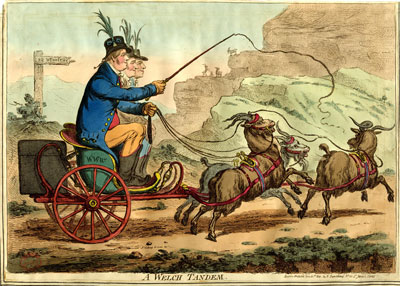A Welch Tandem
This is a wonderfully fanciful portrait caricature of Sir Watkin Williams Wynn, the largest landowner in Wales, and his two younger brothers, Charles and Henry. They are shown riding in a small cart drawn by mountain goats on their way (as the sign behind them indicates) "To Wynnstay," their ancestral home.

© Trustees of the British Museum
Like many portrait caricatures, the title of the print is both a clue to the identities of the subjects and a pun. The "Welch Tandem" describes the brothers seated together in their carriage,("a group of two or more arranged one behind the other" and the specific kind of carriage (a tandem cart) "drawn by horses [in this case goats] harnessed one before the other."
But, of course, there are other clues as well: the distinctively mountainous Welsh landscape through which they travel, the proliferation of goats (the Welsh national animal), the leeks in their hats (another Welsh symbol), and, even more specifically, the "WWW" on the side of the carriage, and the motto inscribed on the hat of Sir Watkin. As one of the most powerful and influential men in Wales, Sir Watkin was sometimes called "The Prince of Wales.", so Gillray adds the motto of the real Prince of Wales "ich dien" to Sir Watkin's hat.
No artist was more inventive in creating variations of portrait caricatures than Gillray. And A Welch Tandem is a perfect example.The traditional portrait caricature as handed down by Italians like Ghezzi and by the English macaroni prints of the Darlys consisted of a full length profile of a standing subject against a virtually blank backround. The identity of the subject was usually alluded to (but not disclosed) in the title and/or by details in the portrait. A good example is the early portrait caricature by Gillray of Richard Brinsley Sheridan (1789).
But Gillray soon began playing variations on the theme: adding better realized backgrounds as in Symptoms of Deep Thinking (1800), departing from the standard profile to include three quarter perspective as in Councellor Ego (1798), face forward as in The Military Caricaturist (1799), and even rear views as in Patern-Staff. Weymouth (1797), depicting his subjects seated or on horseback as in Georgey a' Cock-Horse (1796), and adding more than a single figure to the design as in Pylades & Orestes (1797).
A Welch Tandem includes a number of these variations, but still conforms to the basic portrait caricature tradition in presenting its subjects in profile and with only clues to their real identities. Gillray also injects a little crude humour as the lead goat farts in the face of his two team members.
Sources and Reading
- Commentary from the British Museum on A Welch Tandem.
- "Sir Watkin Williams-Wynn, 5th Baronet," Wikipedia
- "Charles Williams-Wynn (1775-1850)," Wikipedia
- "Henry Watkin Williams Wynn," History of Parliament
- Thomas Wright and R.H. Evans, Historical and Descriptive Account of the Caricatures of James Gillray #501.
- Thomas Wright and Joseph Grego, The Works of James Gillray, the Caricaturist; With the History of His Life and Times, p. 283.
Comments & Corrections
NOTE: Comments and/or corrections are always appreciated. To make that easier, I have included a form below that you can use. I promise never to share any of the info provided without your express permission.